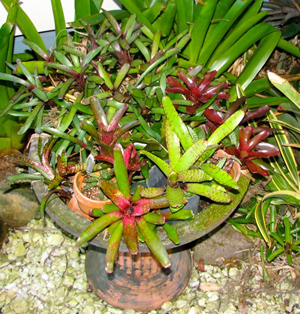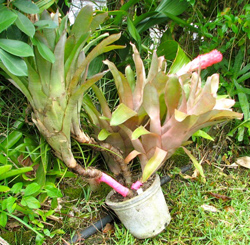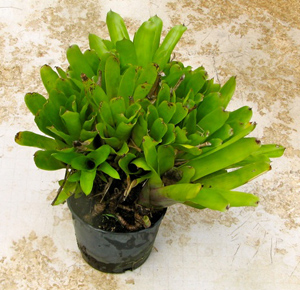FREQUENTLY ASKED QUESTIONS
- How much sun does a bromeliad need?
- How much should I water my plant?
- What do I do when the flower starts dying?
- What do I do with the new plants which start growing at the base of my old bromeliad?
- What kind of potting medium should I use?
- Should I fertilize my plant?
- Are mosquitoes a problem?
- May I bring my plants into Hawai‘i??
Information on Propagation
How much sun does a bromeliad need?
This depends on the genus your plant belongs to. If you are not sure of the identification you can use the leaves as a guide. Guzmania and Vriesea have smooth green leaves with no thorns. They only need filtered light and do not do as well in bright sunlight. The plants with thicker thorny leaves like Aechmea and Portea can take full sunlight. In-between plants like Neoregelia need some sunlight to develop the colors in the leaves.
How much should I water my plant?
More bromeliads are killed by over watering than under watering. The plant itself should have water in the cup in the center at all times. They take very little water from the soil. The soil should be light and well drained so the roots don’t begin to rot. Keep the soil damp but not wet and soggy.
What do I do when the flower starts dying?
When the inflorescence becomes unsightly you can cut it off. The plant is still healthy and can be enjoyed for the foliage. You will notice small shoots growing from the base. These are new bromeliads which can be separated and planted.
What do I do with the new plants which start growing at the base of my old bromeliad?
These new plants are called shoots, offsets, pups, or keiki (Keiki is the Hawaiian word for baby). You can separate them when they are about 1/3 to 1/2 the size of the mother plant and pot them.
What kind of potting medium should I use?
Bromeliads need a loose, well-draining medium. Our members use a variety of mixes with good results. Local growers have been using a half-and-half mixture of coir and black cinders. Another popular mixture is peat moss and perlite.
Should I fertilize my plant?
Some fertilizer will help you have a healthy plant. Too much will give you greener, longer leaves than you want. when you first pot your bromeliad add some Nutricote 13-13-13 time release fertilizer to get it off to a good start.
Are mosquitoes a problem?
This has been the subject of controversy. Mosquitoes breed in water but different species of mosquito like stagnant water, mud puddles, and other sources. Many growers in dry area have few mosquitos even though the bromeliads themselves always contain water. If you think mosquitoes are a problem you can spray your bromeliads with a dilute soap solution. This will break down the surface tension so the mosquitoes can’t breed in the water in the cup. For more information, see our April 2011 newsletter.
May I bring my plants into Hawai‘i?
The State of Hawai‘i has strict restrictions on importing bromeliads. If you are bringing in plants personally, you must declare all plants and plant parts, and present them to a Plant Quarantine inspector. Plants sent by mail, UPS, FedEx, etc., must be shipped to the Hawaii Department of Agriculture plant quarantine station. For more information, see "Importing Bromeliads to Hawai‘i," a brief guide prepared by renowned grower Sharon Petersen.
PROPAGATION AND THINNING
In general bromeliads are propagated by dividing mature plants or by removal of keiki (pups or offshoots) from a mature plant. Keiki can be separated from the mother plant when they are about one-third to one-half the size of the mother. They can also be grown from seed, but it takes much longer.
Even if you are not growing additional plants, bromeliads in pots or outdoors should be thinned. A plant given adequate space will develop a symmetric shape which gets lost if it is crowded. After you get over your fear of damaging your plants, it is simple.
Neoregelia (Neos) are the easiest to divide. Small plants form a short woody stolon with the new plant on the end. The stolon can be cut anywhere along the woody part. The new plant can be potted, put in rocky ground, or tied to a frame or limb. Larger Neos can be divided by pulling keiki away from the mother slightly. Next, cut it flush against the mother plant with a sharp knife or clippers.
Vriesea and Guzmania are a little more difficult because the pups are tightly nestled in the leaves. Regardless, the same process applies. Pull back the leaves to expose the point of attachment and make a cut close to the mother plant.
The Quesnelia below has outgrown its pot. Because it grew on an angle the plants should be repotted so they can grow upright. Two of the plants are on short stems and two are on long stems. The front two have been marked with fluorescent tape showing where to cut. The one on the right should be cut as far down as possible. The one on the left can be cut anywhere along the woody stem. If you keep an inch or two of stem it is easier to make the plant stand up in the pot until it is able to grow roots to secure itself.
The Aechmea gamosepala below needs to be divided and repotted. Pull it out of the pot. Don't worry about damaging the roots. Spread the plant and clip the woody stem next to the base to form smaller clumps or individual plants to be potted separately. Click on the photo for more photos and instructions.
Most other genera can be separated as described above. If you are unsure of yourself, just bring any of your problem plants to the meetings and we will clean them up and give you grooming tips.
Bromeliads are very simple to grow. If your questions are not answered here, please click on the link to send us your question and we'll be glad to answer it for you.
This site best viewed using Mozilla Firefox | Page last revised: 01.27.2011



